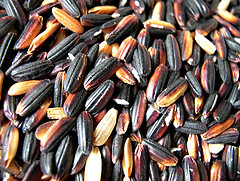Tomato farmers in Ghana have committed suicide after they failed to sell their crop, according to Ghanaweb.com. Apparently a new factory promised to buy all the tomatoes they could grow, and then failed to start on time. I’m sorry for those farmers, but I’m horrified that anyone could put their faith in one buyer — not yet functional — and one crop. I thought it was only modern, high-tech farmers who failed to appreciate the buffering benefits of agricultural biodiversity.
To cork or not to cork
Well, I’m officially in a quandary. On the one hand, with the risk of TCA-induced (that’s 2,4,6-trichloroanisole, a by-product of microbial activity) taint so high, there’s no reason except snobbishness for jettisoning natural cork for screw-tops and other ways of stopping wine bottles. On the other hand, as this article points out, producers are addressing quality concerns and cork is biodegradable, recyclable, and sustainably harvested from woodlands whose management over centuries has led to high levels of biodiversity. Pass the bottle.
Pirates of Lake Victoria
I mentioned a few days ago that the water hyacinth is making a comeback on Lake Victoria, after being almost eradicated by biological control. That’s sparked a small-scale furniture-making industry, but is obviously bad news for fishermen, who are forced to venture further out into the lake to get good catches. That’s far more than just a nuisance, according to an article in The Nation today. The further you go out from shore, it seems, the greater the danger of falling foul of pirates! The veritable heart of darkness that is the nile perch fishery on Lake Victoria is the subject of a very well-reviewed documentary, “Darwin’s Nightmare,” which I hope to see soon. Have you?
Thai rice on the genebank menu
 There was a slightly odd article at Seed Magazine a little while back on Thailand’s efforts to conserve almost extinct varieties of rice in its genebank. Odd because while the story is familiar enough in this kind of piece, the details are slightly confused (or confusing). But no matter, that’s probably only of concern to a pedant like me. The rest of you won’t worry about statements like “farmers across Asia once grew more than 100 varieties of rice, but now that number is down to only 20 or 30 of the most productive types”. Instead, you’ll be thrilled to know that the Thai national collection houses nearly 24,000 varieties, 17,000 of which “are in danger of dying out because they are no longer grown by Thai farmers”. That’s great because SINGER, a window on the world of genebank accessions, lists only 5982 samples from Thailand. Maybe one of those is “the fragrant Pin Kaew variety that was named the best rice in the world at a competition in 1966 but which has since disappeared, having lost out to more productive varieties”.
There was a slightly odd article at Seed Magazine a little while back on Thailand’s efforts to conserve almost extinct varieties of rice in its genebank. Odd because while the story is familiar enough in this kind of piece, the details are slightly confused (or confusing). But no matter, that’s probably only of concern to a pedant like me. The rest of you won’t worry about statements like “farmers across Asia once grew more than 100 varieties of rice, but now that number is down to only 20 or 30 of the most productive types”. Instead, you’ll be thrilled to know that the Thai national collection houses nearly 24,000 varieties, 17,000 of which “are in danger of dying out because they are no longer grown by Thai farmers”. That’s great because SINGER, a window on the world of genebank accessions, lists only 5982 samples from Thailand. Maybe one of those is “the fragrant Pin Kaew variety that was named the best rice in the world at a competition in 1966 but which has since disappeared, having lost out to more productive varieties”.
flickr photo by Stef Noble used under a Creative Commons license. Purple Sticky Rice is rare, but not that rare.
Rice stories
The BBC World Service is broadcasting a series of four programmes on the rice cultures of Asia, called Rice Bowl Tales. Starts 28 February, but if you miss it, it seems like the series has already aired on Radio National, and if you follow the link I’ve just given, you should be able to listen online or download audio files.